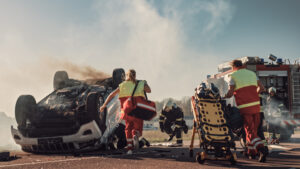Background:
On July 1, 2018, a Utah storyline read “Husband runs over wife, kills her in what police call a terrible accident”. Salt Lake City’s CBS affiliate (KUTV-2) went on to report:
“Investigators said the woman, in her 90’s, got out of the family car to open the garage and her husband hit the car’s gas pedal instead of the brake pedal and ran over his wife and then crashed into the home. Police believe the couple just returned from church.”
Last September in Havertown, Pennsylvania, an 89-year-old man ran over his wife and daughter in the driveway of their home. The incident took place at around 9:30 a.m. when the driver mistook the gas pedal for the brake pedal and proceeded to back into and over his wife and daughter. The man’s 62-year-old daughter was airlifted to the University of Pennsylvania Hospital with head and chest injuries. His wife was taken to the same hospital with serious injuries to her lower torso.
What do these two tragedies have in common? They both:
• involved an older driver
• occurred during the daytime
• occurred in the family’s very own driveway
• involved the driver error of pedal misapplication
• involved family members running over other family members
Introduction:
The purpose of this article is not to be critical of, or Monday-morning-quarterback anyone involved in the above tragedies. Nor is it in any way meant to be an attack on older drivers. We’ve all heard more than enough stories of younger parents backing over their children (or family pet!) in the family’s driveway, illustrating that driveway tragedies are certainly not unique to any one particular age group.
However, as the mission of Keeping Us Safe is to help keep older drivers safe, this article will focus on the more mature driving population.
A couple of boring interesting statistics:
According to the National Highway Safety Traffic Administration (NHTSA), there are at least 500,000 backing accidents every year in the United States. Of those, 15,000 include some type of injury and approximately 210 deaths, mostly children under five (31% of all fatalities) and elderly people aged 70 and over (26%).
Sadly, a whopping 70% of these tragedies occur with a parent or family member behind the wheel.
Helpful tips:
The two stories highlighted above serve as very vivid examples of how quickly things can go wrong, even in our own driveways. The goal of this article is to offer a few simple suggestions that we can all take to prevent similar tragedies from happening to our families.
Following is a non-inclusive list of safety tips, broken down for both the driver and the pedestrian’s perspectives:
Tips for the driver:
• park strategically the day before; practice good “defensive parking” strategies
• don’t back up unless absolutely necessary; advance planning can reduce the amount of required backing. It has been said that if cars were made to backup, the driver’s seat would face the back window.
• always back up slowly; expect obstacles (plan for the worst, hope for the best)
• consider rolling down a window and turning off the radio so warnings can be heard
• make a personal rule that no one gets into or out of your car unless it’s in park
• make a personal rule that no one walks in front of or behind your car unless it’s in park
• make eye contact with the pedestrian as he/she approaches your vehicle
• be aware of your vehicle’s blind spots, and compensate accordingly
• just like school buses do loading and unloading students, don’t begin a driving movement until the passenger has cleared the area of your vehicle
• Take Your Time!
Tips for the pedestrian:
• make eye contact with the driver as you approach the vehicle
• have an out; assume the worse is going to happen
• do NOT walk in front or behind the vehicle until you know it is safe to do so; be a good, defensive pedestrian
• Take Your Time!
A note about vehicle safety features:
Here’s some great news for us all, effective May 1, 2018, NHTSA rules require that backup cameras be standard equipment in all new vehicles. That’s an outstanding, pro-active move that is sure to play an active role in saving lives.
New vehicle safety features are great, but remember that many of these tragedies, or at least many of those involving older drivers, originate from the anomaly known as pedal misapplication (the error of confusing the brake and the gas pedal) as opposed to blind spot or visibility issues. As great as backup cameras are, they’re not going to be very effective in keeping anyone from confusing the brake pedal with the gas pedal (the topic of a future article!).
Emerging vehicle safety technologies such as backup cameras, self-parking vehicles, side mirror-mounted cameras and blind-spot technology are all exciting safety enhancements. However, remember that they are designed to supplement a driver’s safe driving abilities, not to serve in lieu of the critical cognitive and physical skills needed for safe driving.
Drivers should never develop the strategy of relying solely on rear-view cameras and similar safety features to keep them (and others) safe, but bather, we should use them in harmony with preexisting safe, defensive driving techniques.
The importance of physical fitness:
Sometimes we underestimate the important role that flexibility and physical conditioning play in helping keep seniors safe behind the wheel as they progress through the natural aging process.
Exercise can help improve an older driver’s flexibility, coordination, strength, balance and range of motion. Simple stretching exercises can help an older driver look left or right more easily to check their blind spots, or to help ensure a safe lane change. Exercise can also help an older driver turn their neck and body to look behind them before backing, which is obviously very important in driveway safety.
Click here to read more about the importance of strength and flexibility in an article titled ”The Role of Exercise in Older Driver Safety”.
Conclusion:
Driveway tragedies can be prevented if drivers are careful, attentive, and alert. Hopefully, the mere existence of this article will raise awareness on the issue and will help make all of us a bit more careful in our driveways. Proper communication and working as a team (driver & pedestrian together) is sure to reduce the likelihood of future disasters.

Matt Gurwell is the developer of the nationally-recognized “Beyond Driving with Dignity” program. He currently lectures throughout the United States on topics related to the aging process and its adverse affects on driving skills. As developer of this life-saving program, Matt’s mission is to provide strategies and guidance to seniors that will help them to continue driving safely until the decision is made to retire from their driving career. The “Beyond Driving with Dignity” program also provides an excellent array of services and resources for both families and professionals as they deal with this very sensitive issue. Matt retired from a very distinguished and successful 24-year career as an Assistant District Commander with the Ohio State Highway Patrol. After leaving the Patrol, Matt has participated in a tremendous amount of work in the area of older driver research, best practices, current vehicle safety technologies, and adaptive equipment. Matt's creative, innovative and common sense approach, combined with his uncanny ability to bring calm and resolve to stressful situations without ever jeopardizing the dignity of others, has contributed greatly to the success of the “Beyond Driving with Dignity” program. When asked what the ultimate motivation was for starting the program, Matt explains: "There was never one particular event. It was the result of 20-plus years of holding dying people in my arms at terrible car accidents, and delivering dozens and dozens of death notifications to families. I would much rather work with families to bring a peaceful resolve to this sensitive and uncomfortable issue now, rather than have them deal with it when a State Trooper is knocking on their front door". Matt serves as Senior Care Authority’s Program Director for the “Beyond Driving with Dignity” program. Senior Care Authority (https://www.seniorcareauthority.com) is now the nation’s exclusive provider of the “Beyond Driving with Dignity” program.













Comments for this article are closed.